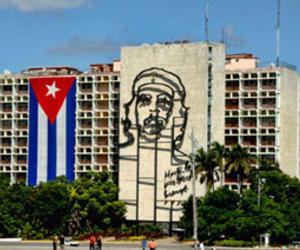José Martí Revolution Square is becoming 50 years old
- Submitted by: manso
- Editorial Articles
- 07 / 27 / 2011

By: Angel Rodríguez. 07/26/2011. The idea of building a square to pay tribute to our national hero, Jose Marti, goes back to 1935. However, it was only in the beginning of the 40’s that people started to work in its conception and was defined where would it placed: the Catalanes Hill.
The project was taken to competition and was won by the sculptor Juan Jose Sucre and the architect Aquiles Maza, who had finished in the third place. The government of Fulgencio Batista ordered the public employees to give to working days and was held a postage stamp emission with obliged contribution, with which were collected millions of pesos, a good part of them, however, were misappropriate.
Works started a little later and were paralyzed from 1944 and until 1952. They started again after the coup d stat of the 10 of March 1952 and the idea was to have the project finished for the centenary of the birth date of Jose Marti in 1953, but they were stopped once again. In 1959, after the triumph of the revolution, the buildings and the great statue were yet to finish and in an abandon state.
The revolutionary government finishes it. The monument has a diameter of 78.50 meters, while the pyramid is 27.29 meters and its height is 112,075 meters built in the form of a star. The monument is completely covered with 10 thousand tons of Cuban marble.
The statue of the Hero is 18 meters height and is made of marble from the Isla de la Juventud.
The Square is surrounded by other buildings, the Central Committee of the Cuban Communist Party, the State Council, the Ministry of the Armed Forces, the Interior Ministry, the Ministry of Informatics and Communications and the Ministry of Economics and Planning as well as the National Theatre and the Jose Marti Library.
At the beginning it was named Civica Square and then became the Jose Marti Revolution Square, through the resolution 151 issued the 17 of July 1961, by the Havana Commissioned (Mayor).
La Plaza (The Square) as the people affectionate name it, became an emblematic place of the country and it is, together with the castle of Morro, the internationally most popular image of Cuba. It is an obliged visit of every foreigner when they arrive to the capital.
Its fame became for being the place from which the Chief Commandant Fidel Castro has spoken to the people and to the world in the most important events, military and popular parades, which in many occasions have exceeded the million participants.
The square became a political and cultural centre of the country. People still remembers the I and II Declaration of Havana, the farewell of the mourning to the Cubans who died in the terrorist attack against a Cuban airplane in the shores of Barbados in October 1976, the tribute to Ernesto Che Guevara, in honor of his death in 1967 as well as many other, until the resent military and popular parade in celebration of the 50 years of the Victory in Bay of Pigs and the definition of the socialist character of the Revolution.
Cubans identify it as a combat trench and the place of permanent denunciation against imperialism and its injustices, since people have come to the Square to show they behavior and revolutionary faith.
Source: cubasi.com
Comments